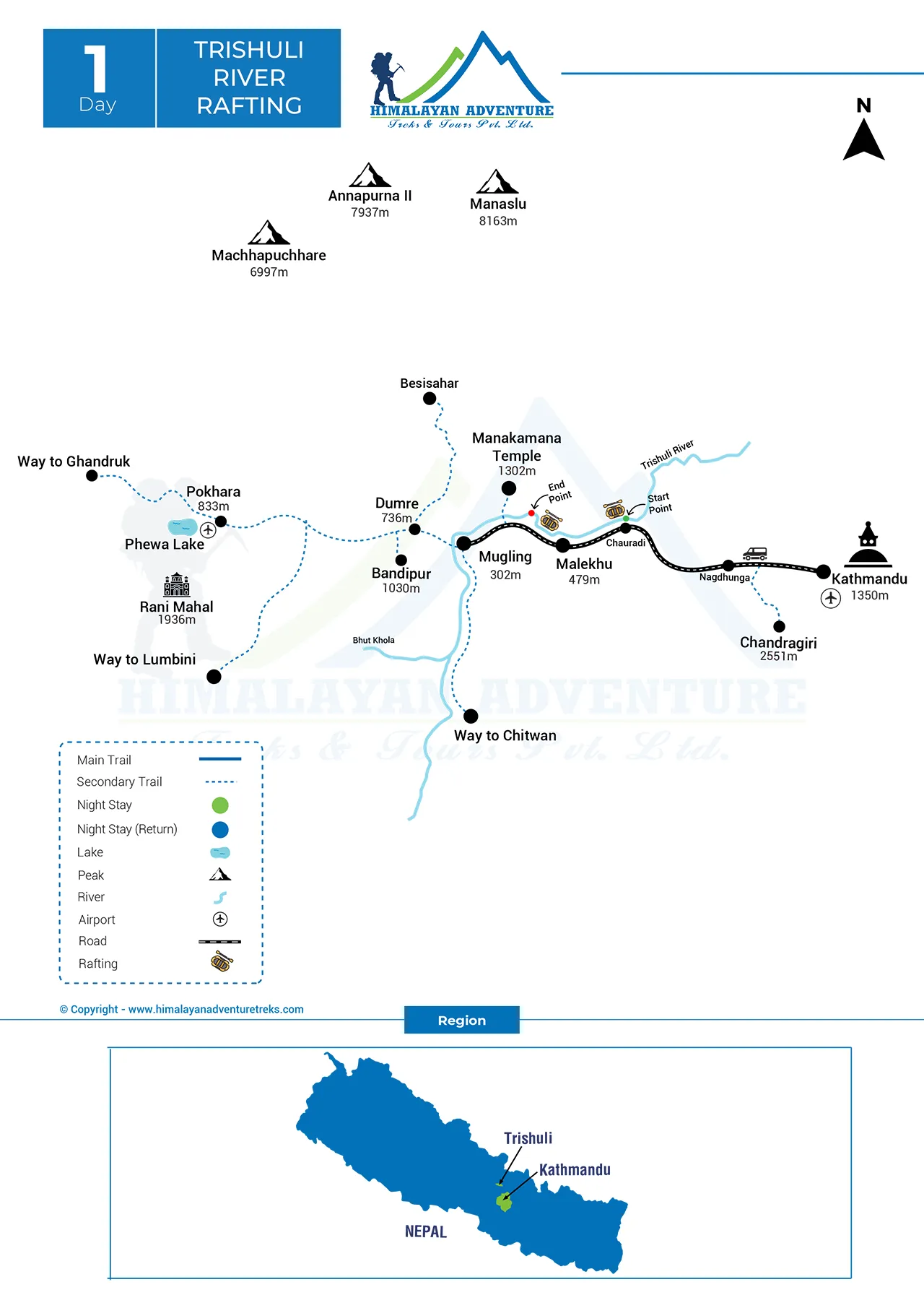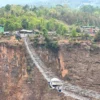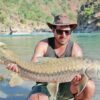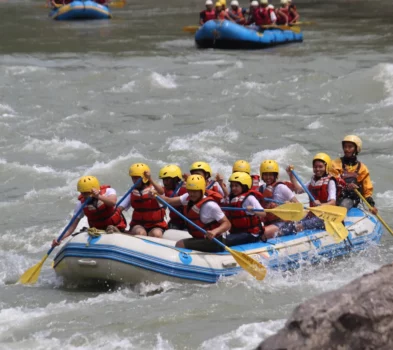Duration
1 DayTrishuli River Rafting
Trip Grade
ModerateGroup Size
1-16 PeopleMax Altitude
950m. / 3,117ft.Best Season
Mar-May/Sept- NovActivity
RaftingMeals
LunchTrip Customization
On request (click here)Highlights of Trishuli River Rafting
- A scenic drive from Kathmandu to Trishuli.
- Thrilling rafting in Trishuli river up to Mugling.
- Enjoy lunch at the riverside with beautiful views of hills and rivers.
Trip Introduction
Trishuli River Rafting day tour is a famous rafting trip in Nepal that attracts locals and foreign tourists alike. The Trishuli River is filled with thrill and exciting rapids, which are perfect for beginners as well as experts. You raft from Charaudi and continue down to Mugling. Thus, the rafting trip is the perfect getaway from mundane life as you embrace the delights of nature.
Early morning, you’ll have breakfast and begin the drive from Kathmandu. After three hours of driving, you’ll reach Charaudi, which is the starting point of rafting. The rafting guide will give necessary information about rafting and its techniques. Then, you get on a rafting boat and kick-start the trip. You will indulge in around 4 hours of unlimited fun. Under guidance, you can swim in some areas of the river that are not dangerous. You’ll come across many rapids, and the guide will instruct you continuously while on the adventure. In addition, high-speed water gives you more thrill and adds to the adventure. After you finish rafting, you’ll freshen up and have lunch. You enjoy the view from the riverside and take a rest. Lastly, you’ll depart for your next destination or drive back to Kathmandu.
Therefore, this creates a base for people wanting to raft on bigger and difficult rivers. Trishuli river rafting also offers you beautiful views of the forests and hills around the river.
Trishuli river rafting is comparatively easier than in other rivers. Therefore, it can be enjoyed for most parts of the year. However, the monsoon season sees an increase in water levels and violent rapids. As such, any age group can participate in the Trishuli River Rafting.
We, at Himalayan Adventure Treks, offer you different packages for Trishuli River Rafting at affordable prices. We have experienced guides and provide you with great dining and transportation. Also, you can go on other tours after rafting.
Outline Itinerary of Trishuli River Rafting
Day 01: Trishuli River Rafting.
Our guests sharing their experiences (Photo/Video Gallery)
Detail itinerary of Trishuli River Rafting
Day 01: Trishuli River Rafting.
06:00 – Breakfast at the hotel
07:00 – After breakfast, we catch the tourist bus in Sorekhutte. By Tourist, the bus takes about 3 hours to reach the starting point called Charaudi. Once you arrive, your rafting guide will come to pick you up on the bus. The Rafting guide gives you all the information regarding rafting.
10:00- Around 10 am, rafting starts and will go for 2-3 hours on the Trishuli River.
02:00- After finishing the rafting, fresh and having Lunch at the riverside, enjoying the view of high mountains and deep valley.
3:00-Then Then departure to the next destination by Local bus. (Kathmandu, Pokhara, or Chitwan)
Activity: Rafting, 3-4 hours
Max. Altitude: 950m/3,117ft. Trishuli River
Meal: Lunch
Note:
If you have your own private group and want to make your trip private, we can run the custom trip all the day as per your requirements and group size.
Includes and Excludes
What are included with package?
- Professional English-speaking licensed guides: Our guides are highly trained and certified in Whitewater River Guiding, Swift Water Rescue, and Wilderness First Aid, ensuring your safety and providing expert guidance throughout the experience.
- Professional safety kayakers: Experienced safety kayakers are on-hand to assist and ensure safety during the rafting, ready to react quickly in case of an emergency.
- Rafting equipment: All necessary rafting gear, including helmets, Personal Flotation Devices (PFDs), paddles, splash jackets, and wetsuits, is provided for your protection and comfort.
- Lunch at the side of Trishuli River: Enjoy a delicious lunch along the scenic riverbanks, taking in the natural beauty of the area while you refuel during the trip.
- River permits: The necessary river permits required for rafting activities are included to ensure everything is legally and safely managed.
- Industry-standard first aid kits: First aid kits, stocked to industry standards, are available throughout the rafting journey to handle any minor injuries or emergencies that might arise.
What are not included with package?
- Unrelated transportation, accommodation, visas, travel documents, departure taxes, etc: Any transportation, accommodations, visas, or other travel-related documents outside the rafting activity are not included. Participants are responsible for arranging their travel to and from the rafting point, along with any required visas or departure taxes.
- Footwear: Participants need to bring their own suitable footwear for rafting. Ensure you have water-friendly shoes that provide comfort and safety during the activity.
- Transportation to reach rafting point and return: Travel to and from the rafting point is not included. Participants must arrange their own transportation to the starting location and for the return trip after the rafting.
- Items of a personal nature including swimwear, towel, and toiletries: Personal items such as swimwear, towels, and toiletries are not provided and must be brought by participants.
- Insurance: While we provide insurance for our crew, participants must have their own insurance that covers emergency medical treatment and travel-related incidents, including evacuation if necessary. Ensure your travel insurance covers rafting activities specifically.
Pick Your Suitable Date
Book a Private Trip
Private & Group Discount Price
-
1 -
1 person
US$ 100
-
2 -
2 people
US$ 95
-
3 -
5 people
US$ 90
-
6 -
10 people
US$ 80
-
11 + people
9999
US$ 65
Total Cost:
US$ 100
Route Map & Altitude Chart
Kathmandu
Start/End point
Kathmandu
Trip Information
About Country
Popularly recognized worldwide for its majestic sky-dominating peaks, Nepal is one of the most sought-after nations for trekking and other adventure activities. This tiny Himalayan nation is home to eight of the world’s tallest peaks, including Mt. Everest (8848.86m)- the highest mountain in the world. Moreover, the rugged and rural trekking trails to the massifs along the dense forest which is filled with exotic floras and faunas instills excitement and adventures to the travelers.
However, traveling to Nepal is not only about the mountains and natural beauty. Unraveling the beauty that lies in the old monuments, palaces, and temples. Nepal has a diverse array of cultures, traditions, languages, and history which are reflected in the lifestyle of the people.
Key Facts
Location: Nepal is located in South Asia; between two great giants the Republic of China to the north and India to the south, east, and west.
Geography: A landlocked country, Nepal is divided into three geographical regions, namely, the Himalayas, the Hills, and the Terai.
Capital: The capital city of Nepal is Kathmandu.
Area: The total area of Nepal is 147,181sq km.
Population: The current population of Nepal is 29 million.
Political system: Nepal is a federal republic country with a multi-party system.
Major religion: Nepal is a secular state but the majority of people follow Hinduism, followed by Buddhism and Christianity.
Time zone: The time zone of Nepal is GMT +5:45.
Official Language: The official language of Nepal is Nepali.
Working hours: The working hours in Nepal are from 10 am to 5 pm.
Electricity: Currently, all the major cities have electricity while electricity supply in some rural areas is limited. The standard voltage of electricity in Nepal is 220V.
Visa Information
All tourists visiting Nepal except tourists from India should have a valid passport and visa. An On-Arrival visa to enter can be obtained at the Tribhuvan International Airport or any other land entry/exit points at the Nepal-Tibet and Nepal-India border. During the peak season, there will be a long line of tourists here trying to get their visas. So, to avoid the endless waiting you should visit the nearest Nepalese diplomatic missions stationed in your country before your arrival.
An On-Arrival Tourist Visa costs USD 30 for 15 days, USD 50 for 30 days, and USD 125 for 90 days. Find more information regarding the updated visa fees at http://www.nepalimmigration.gov.np/post/notice-regarding-visa-fee-updates.
You can also extend your visa within a valid period which will cost you USD 3 per day. However, if you are visiting Nepal from SAARC countries you don’t have to pay visa fees as gratis fee or free visa is applicable for 100 days. Regarding information about tourist visas, you can head to the information on the official website of the Department of Immigration at http://www.nepalimmigration.gov.np/page/tourist-visa.
How to reach the country
Nepal is very well accessible via air, rail, and road. Tribhuvan International Airport is the only international airport and the entry point for those arriving by air. Nepal Airlines is the main operator in the nation. Other international airlines here are Air Arabia, Air Asia, Etihad airlines, Fly Dubai, Jet Airways, Malaysia Airlines, Qatar Airways, Silk Air, and Thai air. The rail and road service can only be used by those arriving from India.
In terms of land transport, there are several land entry/exit points at the Nepal-Tibet and Nepal-India borders. Kerung and Kodari are the entry/exit points at the Nepal-Tibet border whereas
Janakpur-Jainagar railway is the sole railway that connects Nepal with India, several buses connect Delhi and Kathmandu.
Popular destinations to visit
There are many places you can visit in Nepal. Nepal is not only gifted with natural beauty but it is also culturally rich which means there are many heritages and sites you can visit. Kathmandu Valley is the first and foremost destination that you should not miss out on. The seven UNESCO world heritage sites in the valley, namely, Patan Durbar Square, Bhaktapur Durbar Square, Kathmandu Durbar Square, Pashupatinath, Swayambhunath, Boudhanath, and Changunarayan.
Other places you must visit while in Nepal are Pokhara, Chitwan, and Lumbini. Pokhara is a scenic lake city, located 6 hours’ drive away from Kathmandu city. There you will be able to enjoy the serene and peaceful nature with the Annapurna ranges in the backdrop. Lumbini, the birthplace of Lord Buddha, is a historic destination whereas the Chitwan National Park is a natural haven for exotic flora and fauna. Both of these are also enlisted as world heritage sites by UNESCO. Palpa, Bandipur, Bardia National Park, and Ilam are some of the popular destinations.
As for trekking and mountaineering activities, Annapurna, Everest, Langtang, Manaslu, Upper Mustang, and Dolpo regions are some of the most popular ones in Nepal.
Internet and Communication in the country
You do not have to worry about not getting communication service or Internet service in Nepal. In recent years, the internet and communication services have drastically progressed and developed. While in the major cities and tourist destinations, you can use free Wi-Fi including many of the cafes and restaurants. Similarly, almost every hotel and some public areas provide Wi-Fi services. However, Wi-Fi is not always available in remote areas in the Himalayas and rural Hilly regions.
In such situations, a cellular connection is the best option for both Internet access and communication. NTC and Ncell at two of the biggest telecommunication corporations and offer sim cards with various packages at a reasonable price. These service providers have a wide reach over many parts of Nepal. You will easily be able to purchase any sim card with your passport or identity card.
Local currency and foreign exchange
While in Nepal, you should use Nepali rupees (NRs) which is also the official currency of Nepal. You can easily exchange your currency into the Nepalese Rupee at the Tribhuvan International Airport or the exchange counters and banks around the major cities. Also, the major cities like Kathmandu, Pokhara, Chitwan, and Lumbini have a great availability of banks and ATMs. However, their availability becomes quite scarce when you head to the Himalayas and remote areas.
So, it is best if the travelers perform all their money-related activities while they are in the major cities.
Weather and climate
The climate in Nepal varies according to altitude and the current season. The lowland of the Terai region in the southern part of the country is very hot and humid during the summer. The temperature there can get as high as 45 degrees Celsius. The middle part is also known as the hilly region has a pleasant and bearable climate all year long. However, in winter the nights and early mornings can get quite chilly. The Himalayan region is the northernmost part of the country and is above 3300m. This region usually has alpine climatic conditions and during the winter season, it experiences adverse weather conditions.
Nepal generally has four seasons, namely, spring, summer, autumn, and winter. The spring here means every part of the country has flowers blooming and summer means a lot of humidity and rainfall. While the autumn is neither too hot nor too cold and the skies are always clear. The winter season brings snow in the Himalayan region and some parts of the hilly region as well. Finally, during the monsoon season, the entire country experiences heavy rainfall except in the rain shadow areas of Upper Dolpo and Mustang.
People, culture, and festivals
Nepalese are known to be one of the kindest people all over the world. With a smile on everyone’s face, you will be warmly welcomed and greeted. The word “Namaste” is used while they join their hands together which means a respectful greeting. Nepal is a culturally rich country with many different castes, languages, and traditions. The diverse culture and tradition result in many different festivals celebrated all around the nation.
The major festivals celebrated are Dashain, Tihar, Holi, Sonam Losar, Gyalpo Losar, and many more. Especially in Newari settlements, people celebrate many colorful and radiant festivals. You will be able to experience wonderful and lifelong memory if you visit Nepal during the time of festivals.
What do you need to bring on the Trip?
- T-shirt.
- Swimming wear for on the river.
- Warm clothing for the evenings including a fleece or a pullover.
- Sunscreen and lip protector.
- Sunglasses (with retaining device) or a cap.
- Towel and Toiletries (environmentally friendly is best).
- Personal medication.
- Footwear.
Frequently Asked Questions
Where does the Trishuli River rafting trip begin and end?
The rafting trip begins at Charaudi and ends at Mugling, both located along the Prithvi Highway. Charaudi is about a 3-hour drive from Kathmandu, making it an accessible and popular rafting spot.
How long does the Trishuli rafting experience last?
The actual rafting lasts for approximately 3.5 to 4 hours. Including transportation, lunch, and rest time, the entire day tour takes around 8 to 10 hours.
Is Trishuli River rafting suitable for beginners?
Yes, the Trishuli River is considered ideal for beginners. It features Class II to III+ rapids, which are thrilling but manageable with proper safety instructions from a licensed rafting guide.
What is the best time of year for Trishuli River rafting?
The best seasons are spring (March to May) and autumn (September to November) when the weather is stable and water levels are optimal. Rafting is available year-round, but caution is needed during the monsoon season (June to August) due to high water levels and stronger rapids.
What equipment is provided during the rafting trip?
Participants are provided with all essential safety gear, including:
-
Life jacket
-
Helmet
-
Paddle
-
Rafting boat
-
Safety briefing and guide
Wetsuits may also be available depending on the season.
Do I need to know how to swim to go rafting?
No, swimming skills are not mandatory. All participants wear life jackets, and the guides are trained in water rescue and first aid. However, basic water comfort is recommended.
Is there an age or weight limit for this activity?
Children as young as 10 years old can participate with parental consent. There is generally no strict weight limit, but participants should be reasonably fit and able to follow safety instructions.
Is food provided during the trip?
Yes, after the rafting session, participants are served a delicious lunch at a riverside resort. Drinking water is also available. Veg and Non Veg options can be arranged on request.
What should I bring with me for the rafting day trip?
You should bring:
-
Quick-dry clothes
-
Towel
-
Extra set of clothes
-
Sunscreen
-
Secure footwear (e.g., sandals or water shoes)
-
Waterproof camera (optional)
Avoid carrying valuables or electronics unless waterproofed.
How do I book a Trishuli River rafting trip?
You can book the trip through trusted tour operators like Himalayan Adventure Treks & Tours, who provide transportation, gear, guides, meals, and full coordination for a seamless rafting experience.

















